| View previous topic :: View next topic |
| Author |
Message |
iangreenhalgh1


Joined: 18 Mar 2011
Posts: 15679
Expire: 2014-01-07
|
 Posted: Fri Nov 20, 2015 5:25 pm Post subject: Posted: Fri Nov 20, 2015 5:25 pm Post subject: |
 |
|
iangreenhalgh1 wrote:
The Carl Zeiss Jena Flektogon 2.4/35, rather than the earlier 2.8 version is the one to get imho. Hard to find anything that beats it that doesn't cost multiple times the cost.
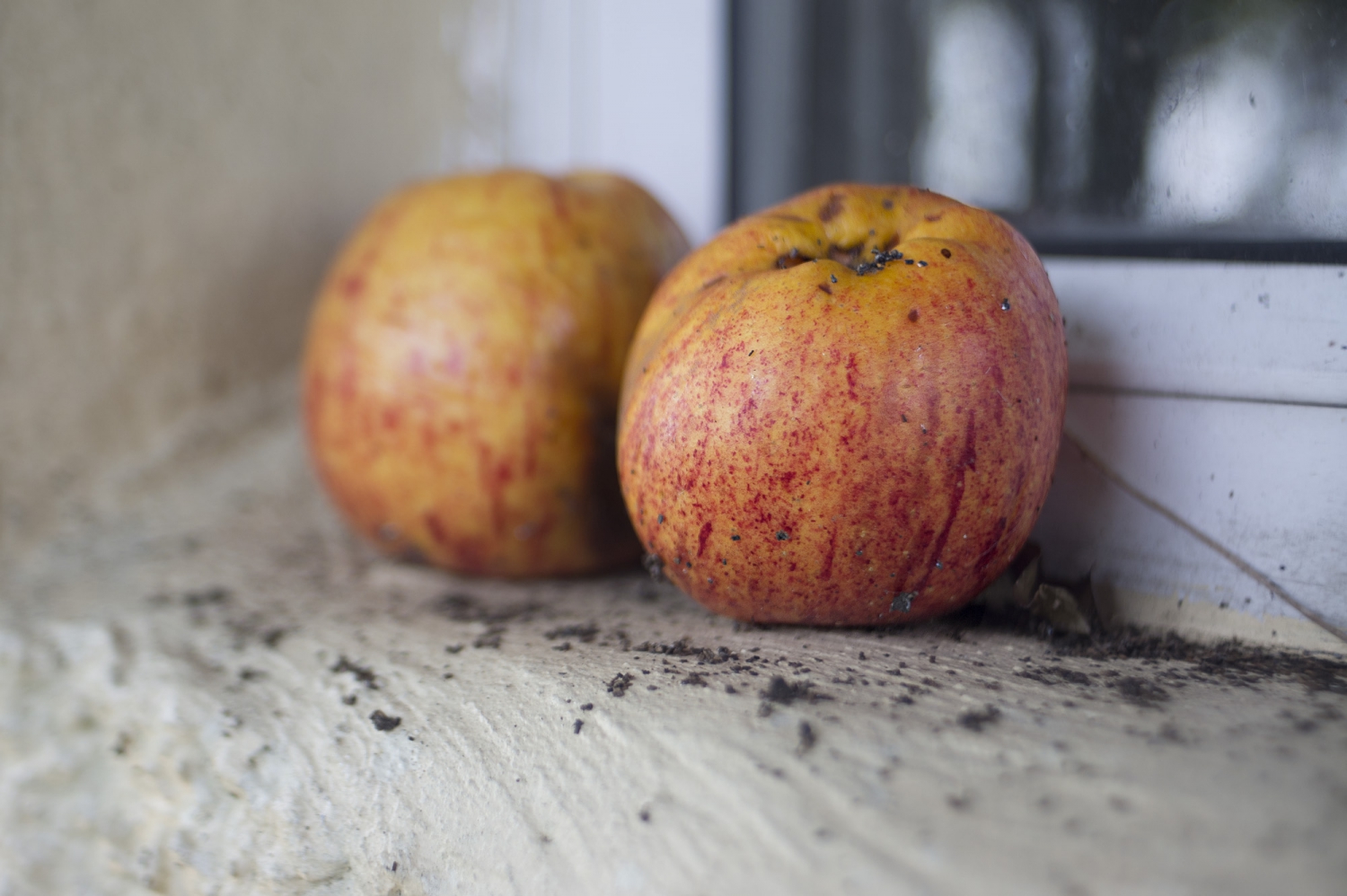

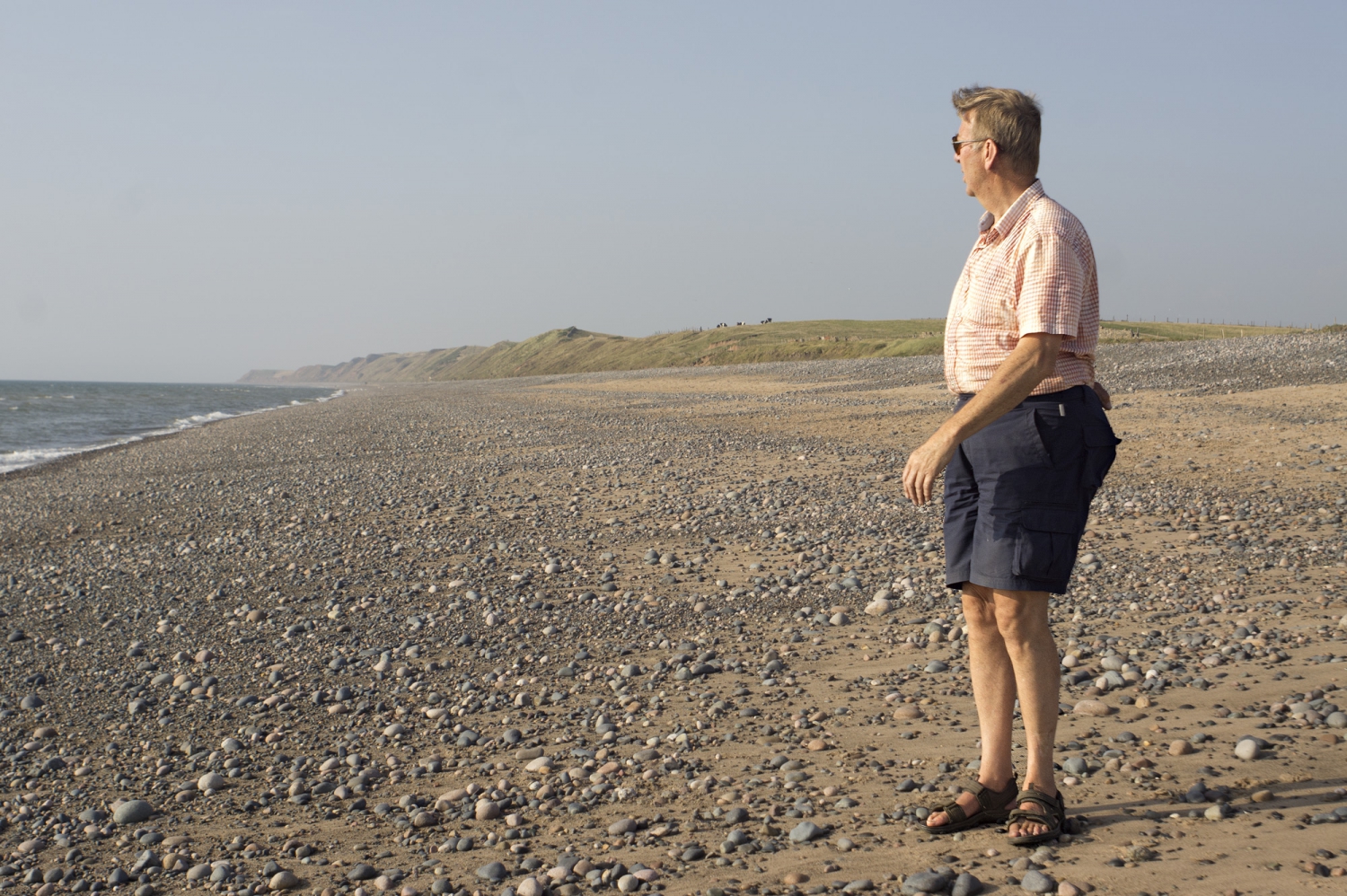
_________________
I don't care who designed it, who made it or what country it comes from - I just enjoy using it! |
|
| Back to top |
|
 |
uhoh7

Joined: 24 Nov 2010
Posts: 1300
Location: Idaho, USA
|
 Posted: Fri Nov 20, 2015 7:34 pm Post subject: Posted: Fri Nov 20, 2015 7:34 pm Post subject: |
 |
|
uhoh7 wrote:
I made two snaps this morning on my A7.mod with my radioactive FD 35/2 SSC (concave front element), which I researched for some time before getting to use on the Nex-5. This was popular with journalists back in the day.
Just like most lenses, character changes dramatically stopped down and wide open

DSC07512 by unoh7, WO A7.mod

DSC07515 by unoh7, Around f/8

DSC07521 by unoh7, on Flickr
These are right out of the camera, with adobe profile. Call me a revisionist, but had I seen such an image as the last one come out of my stock A7 at 35mm, I doubt I would have bought a M9. Yes, the deep corners fade. But overall clarity and edges seem excellent to my eye.
This lens cost 110USD
_________________
Making MFlenses safe for the letter *L*  |
|
| Back to top |
|
 |
hemeterfilms

Joined: 04 Jul 2012
Posts: 80
Location: Mexico City
|
 Posted: Fri Nov 20, 2015 9:44 pm Post subject: Posted: Fri Nov 20, 2015 9:44 pm Post subject: |
 |
|
hemeterfilms wrote:
So just to be clear - the last was from a stock A7 ?
Has the mod made a clear difference with that Canon , as I was under the impression that it only really benefitted some Rangefinder lenses.
It seems a large and heavy lens, but that Canon does impress me. |
|
| Back to top |
|
 |
padam

Joined: 09 Oct 2012
Posts: 175
Location: Hungary
|
 Posted: Fri Nov 20, 2015 10:03 pm Post subject: Posted: Fri Nov 20, 2015 10:03 pm Post subject: |
 |
|
padam wrote:
They remove the AA filter as well if the sensor has it
So it should get sharper with any (good) lens. |
|
| Back to top |
|
 |
uhoh7

Joined: 24 Nov 2010
Posts: 1300
Location: Idaho, USA
|
 Posted: Sat Nov 21, 2015 7:11 pm Post subject: Posted: Sat Nov 21, 2015 7:11 pm Post subject: |
 |
|
uhoh7 wrote:
| hemeterfilms wrote: |
So just to be clear - the last was from a stock A7 ?
Has the mod made a clear difference with that Canon , as I was under the impression that it only really benefitted some Rangefinder lenses.
It seems a large and heavy lens, but that Canon does impress me. |
No, the last is from the A7.mod. This also removes the AA filter. In my opinion it is a totally different camera. Best 400USD I ever spent.
Here again wide open, yesterday.

FJ by unoh7, FD 35/2 SSC Concave. Body: Kolari A7 mod v1
There is an impression the mod effects only RF wides, not just around here, but in other quarters also. This is not the case, in my experience. Stripping the thick Sony sensor cover, which again, is 1.9mm and has optical effects which only native lenses are designed to counter, and replacing it with 1mm Kolari (my version) or better yet the latest .08mm will effect performance of any lens made for film on the camera, for the better. Sure, the degree varies. 
I have alot of experience with both the stock A7r and A7 and many RF and SLR film lenses. I was never happy with either. So much so, I bought M9, which I love, not because it's a Leica, but because it is fantastic with many lenses. Now, I can say, I love the A7.mod also. I hope the photo above shows why. 
Others may scoff at this, and the first question to ask is: have you tried it? Have you owned both? Many people do not want to deal with sending the camera away and the expense, so for them the idea it's "not worth it" for SLR glass is "good news".
I understand the concerns about cost. We can't have everything. I can't have a Leica SL 007 either  But I don't fool myself thinking it is not a whole different league from my current bodies and lenses. But I don't fool myself thinking it is not a whole different league from my current bodies and lenses.
Perhaps it's a combination of the thin filter and removal of AA, I don't know. I know I love a camera that used to collect dust. I know some others out there would love it too, and places like this are where we share our experience. Sadly, in the last few years this forum has gained a reputation for some vocal members not always respecting the experience of other shooters. I've had many PMs at various forums about the attitude of just a few members here. Not friendly.
But I love MFlenses, which has helped me immensely over the years. Sharing my experience, despite an unwelcome attitude from a few, is a way to give back. 
BTW, I was the first person on this forum to use a Nex Camera with legacy lenses. That seemed a bit strange at the time too. 

Canon 85mm f/1.8 LTM by unoh7, on Flickr
_________________
Making MFlenses safe for the letter *L*  |
|
| Back to top |
|
 |
cyrano


Joined: 15 Feb 2013
Posts: 857
Location: UK
Expire: 2016-12-30
|
 Posted: Sat Nov 21, 2015 8:50 pm Post subject: Posted: Sat Nov 21, 2015 8:50 pm Post subject: |
 |
|
cyrano wrote:
Most of the time it doesn't matter a toss. You'll get a good picture with any semi decent lens. Only pixel peepers and nerds get hung up on the minutae.
_________________
A whole bunch of stuff. |
|
| Back to top |
|
 |
iangreenhalgh1


Joined: 18 Mar 2011
Posts: 15679
Expire: 2014-01-07
|
 Posted: Sat Nov 21, 2015 8:58 pm Post subject: Posted: Sat Nov 21, 2015 8:58 pm Post subject: |
 |
|
iangreenhalgh1 wrote:
| cyrano wrote: |
| Most of the time it doesn't matter a toss. You'll get a good picture with any semi decent lens. Only pixel peepers and nerds get hung up on the minutae. |
+10
I still use and enjoy my NEX-3 that I've had for years and is well outdated; I also enjoy using my Pentax Q7 with it's teeny 1/1.7" sensor and my 6 year old Sony a850 can still produce wonderful 24mp FF images, so much so that the only two reasons for me to get an A7 would be to use the lenses that won't fit the a850 and better high ISO performance. I am reluctant because, as good as the EVF on the A7 is, it still isn't as nice as the OVF on my a850.
Back to 35s for the NEX; here's three good ones, of very different sizes and weights:
Canon FL 2.5/35, Zeiss Skoparex 3.4/35 and ISCO Westron 3.5/35:
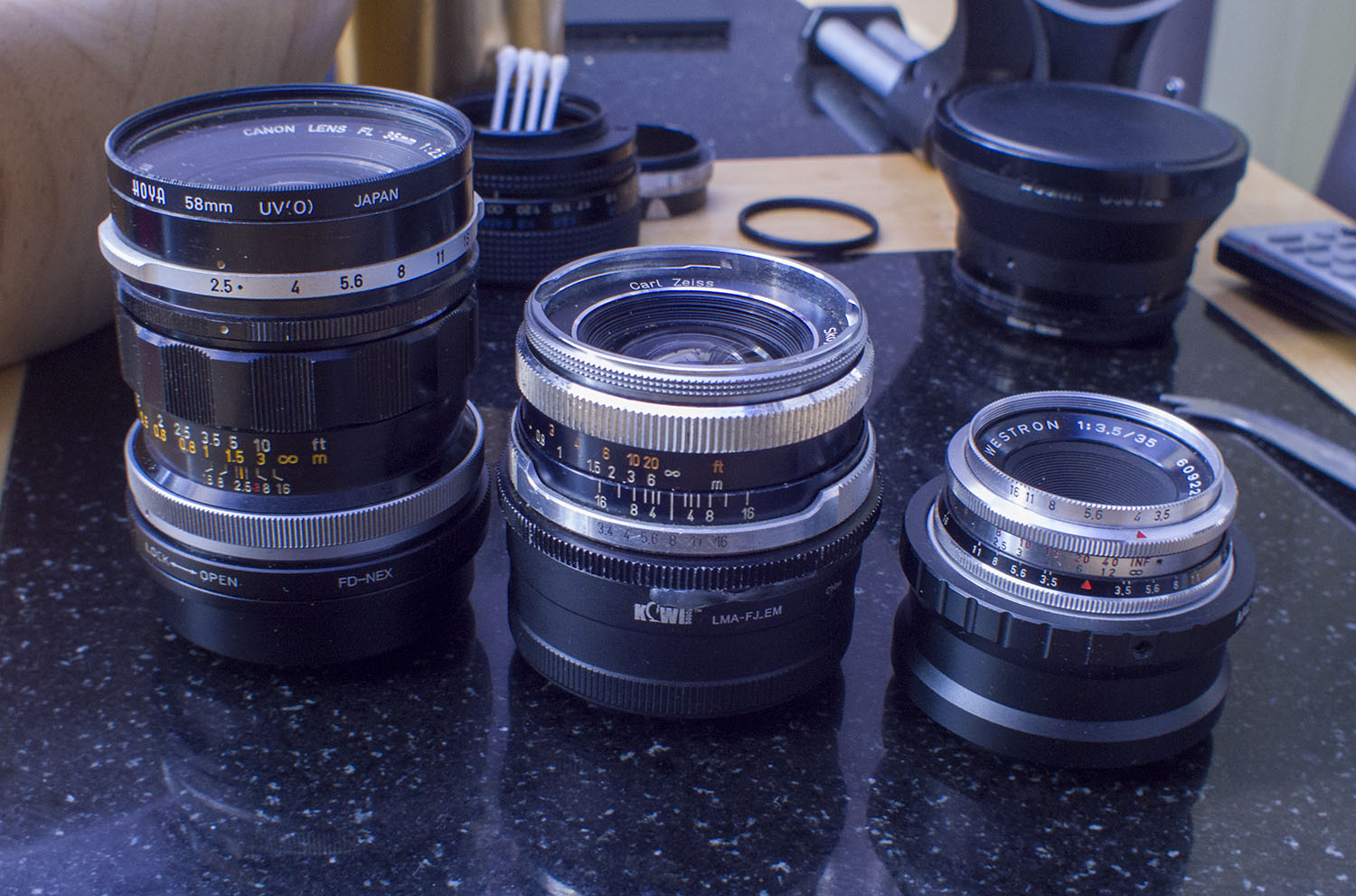
_________________
I don't care who designed it, who made it or what country it comes from - I just enjoy using it! |
|
| Back to top |
|
 |
Lightshow


Joined: 04 Nov 2011
Posts: 3666
Location: Calgary
|
 Posted: Sat Nov 21, 2015 9:46 pm Post subject: Posted: Sat Nov 21, 2015 9:46 pm Post subject: |
 |
|
Lightshow wrote:
| padam wrote: |
They remove the AA filter as well if the sensor has it
So it should get sharper with any (good) lens. |
To my knowledge, they remove the thick lowpass (AA) filter and replace it with a thinner lowpass filter similar to the M9's lowpass filter.
_________________
A Manual Focus Junky...
One photographers junk lens is an artists favorite tool.
My lens list
http://www.flickr.com/photos/lightshow-photography/ |
|
| Back to top |
|
 |
hemeterfilms

Joined: 04 Jul 2012
Posts: 80
Location: Mexico City
|
 Posted: Sat Nov 21, 2015 10:26 pm Post subject: Posted: Sat Nov 21, 2015 10:26 pm Post subject: |
 |
|
hemeterfilms wrote:
Well today I did pay a visit to Calle Donceles in Mexico City where there are many second hand camera dealers.
The very first dealer has TWO Canon 35/f2, one very battered and the other rather good at MX$ 3000 (about 150 UK sterling). None of the other places had anything recommended by the kind members here. So I went back and bought it with an NEX to FD adapter (another surprise that they had in stock).
It has the concave front element , min aperture of f16 and a very pale yellow colouration. No SSC on front but the reflections reveal some kind of blue and amber multicoating
Of course I returned and found my batteries flat so they are currently charging. I will post pix as soon as possible.
I have noticed that the adapter made by K&F Concept allows a little play which is annoying but possibly fixable, also this lens is a really heavy, though the combination with the A7 is not too bad.
Once again , many thanks to all who replied to my original post |
|
| Back to top |
|
 |
iangreenhalgh1


Joined: 18 Mar 2011
Posts: 15679
Expire: 2014-01-07
|
 Posted: Sat Nov 21, 2015 11:13 pm Post subject: Posted: Sat Nov 21, 2015 11:13 pm Post subject: |
 |
|
iangreenhalgh1 wrote:
Congrats, that concave FD 2/35 is a great lens and i am sure will serve you very well.
_________________
I don't care who designed it, who made it or what country it comes from - I just enjoy using it! |
|
| Back to top |
|
 |
uhoh7

Joined: 24 Nov 2010
Posts: 1300
Location: Idaho, USA
|
 Posted: Sun Nov 22, 2015 4:59 am Post subject: Posted: Sun Nov 22, 2015 4:59 am Post subject: |
 |
|
uhoh7 wrote:
| cyrano wrote: |
| Most of the time it doesn't matter a toss. You'll get a good picture with any semi decent lens. Only pixel peepers and nerds get hung up on the minutae. |
A photographer would have to be blind not see the difference in nearly any shot with legacy glass shooting A7 next to A7.mod. The character is different, the AA filter is gone and the stack is thin. You may as well say one lens is the same as another, or one film type is the same as another. There is no peeping about it, the mod is different and you can see it.
That doesn't mean everybody needs to do it. If you shoot APS-C you know FF might be nicer, but it's not always convenient. What you have is good enough for you. Nothing wrong with that. Claiming two different things are the same with no personal knowledge? Why?
Vive la différence! Why compare lenses at all if their subtleties are moot?
| hemeterfilms wrote: |
Well today I did pay a visit to Calle Donceles in Mexico City where there are many second hand camera dealers.
The very first dealer has TWO Canon 35/f2, one very battered and the other rather good at MX$ 3000 (about 150 UK sterling). None of the other places had anything recommended by the kind members here. So I went back and bought it with an NEX to FD adapter (another surprise that they had in stock).
It has the concave front element , min aperture of f16 and a very pale yellow colouration. No SSC on front but the reflections reveal some kind of blue and amber multicoating
|
Congrats!! Hope you will post some samples here some point and share your impressions. It is a very heavy lens, but a famous one.
If you keep it in a closet, the yellowing will increase. This was prized by BW film shooters. Storage in sunshine will mellow the yellow. It's most apparent WO. The lens is mildly radioactive, so do not store it under your pillow. I'm not kidding.
_________________
Making MFlenses safe for the letter *L*  |
|
| Back to top |
|
 |
iangreenhalgh1


Joined: 18 Mar 2011
Posts: 15679
Expire: 2014-01-07
|
 Posted: Sun Nov 22, 2015 10:00 am Post subject: Posted: Sun Nov 22, 2015 10:00 am Post subject: |
 |
|
iangreenhalgh1 wrote:
What do you have to be to see differences between lenses when they are stopped down past the diffraction limit? 
_________________
I don't care who designed it, who made it or what country it comes from - I just enjoy using it! |
|
| Back to top |
|
 |
Gerald


Joined: 25 Mar 2014
Posts: 1196
Location: Brazil
|
 Posted: Sun Nov 22, 2015 12:53 pm Post subject: Posted: Sun Nov 22, 2015 12:53 pm Post subject: |
 |
|
Gerald wrote:
After Nikon has canceled the effect of the anti-aliasing filter in the D800E, many people began to see the AA filter as undesirable. They think that the removal of the AA filter improves the image produced by a camera. I don’t think so. Let me say that in the Sampling Theory the AA filter is essential to eliminate the possibility of artifacts. To give an example of artifacts due to the absence AA filter, take a look at the images below, produced by a Nikon D7200 (w/o AA filter) and a Sony A77II (w/ AA filter). The images are 200% crops from the studio scene of DPR.
Nikon D7200 - 200% crop:
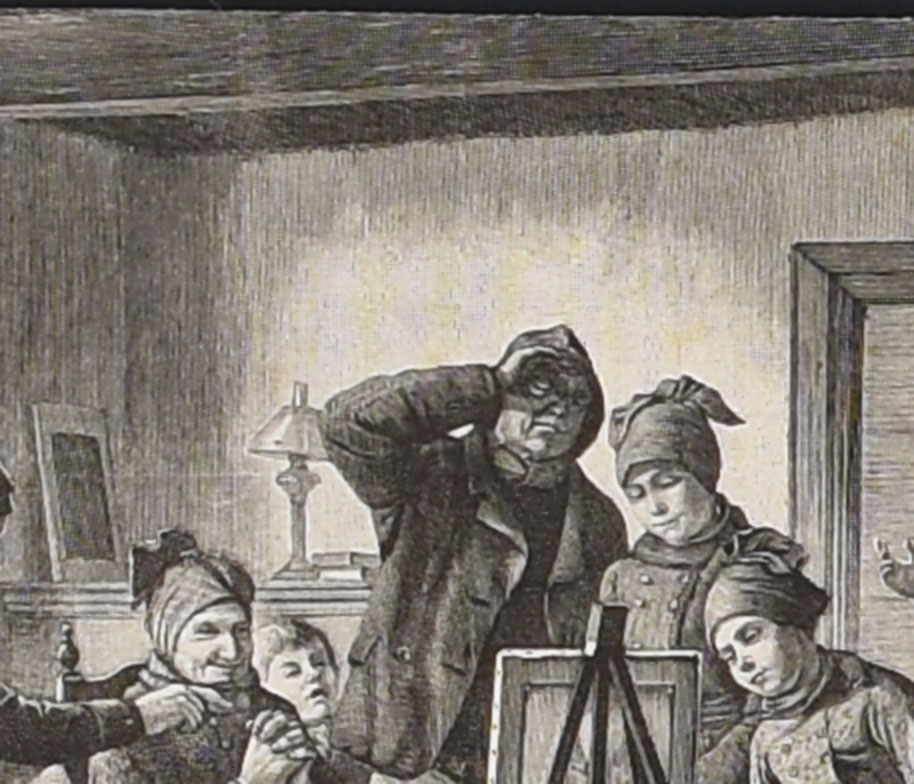
Sony A77 II - 200% crop:
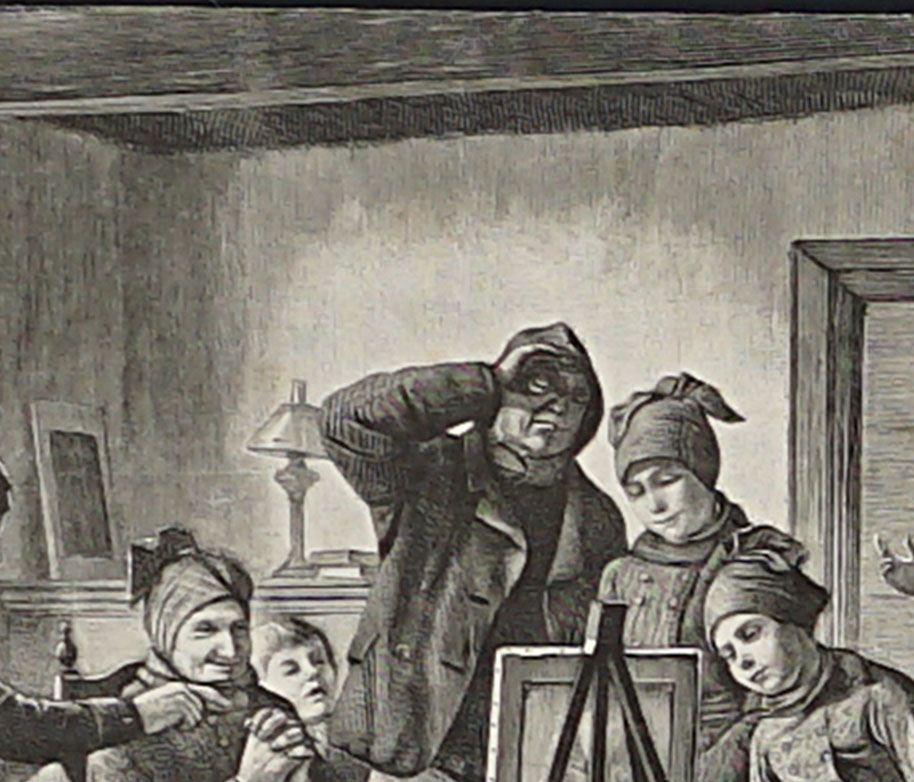
The highly visible yellow stains in the image from the D7200 are just artifacts due to lack of AA filter. In contrast, the image produced by A77II is free of artifacts while details are pretty well preserved. By the way, one thing which is not widely known is that the image produced by a camera with AA filter stands stronger sharpening in PP before haloing becomes apparent. In other words, PP can be used to reclaim the details smeared by the AA filter action without introducing significant side effects.
_________________
If raindrops were perfect lenses, the rainbow did not exist. |
|
| Back to top |
|
 |
iangreenhalgh1


Joined: 18 Mar 2011
Posts: 15679
Expire: 2014-01-07
|
 Posted: Sun Nov 22, 2015 1:20 pm Post subject: Posted: Sun Nov 22, 2015 1:20 pm Post subject: |
 |
|
iangreenhalgh1 wrote:
Yes, Gerald is correct, the minor difference in sharpness you get without an AA filter can be overcome by use of sharpening; I noticed this a while back as I own cameras with and without AA filters.
Another problem caused by a lack of an AA filter is moire. You can see it here on the escalator:

_________________
I don't care who designed it, who made it or what country it comes from - I just enjoy using it! |
|
| Back to top |
|
 |
cyrano


Joined: 15 Feb 2013
Posts: 857
Location: UK
Expire: 2016-12-30
|
 Posted: Sun Nov 22, 2015 6:11 pm Post subject: Posted: Sun Nov 22, 2015 6:11 pm Post subject: |
 |
|
cyrano wrote:
| uhoh7 wrote: |
| cyrano wrote: |
| Most of the time it doesn't matter a toss. You'll get a good picture with any semi decent lens. Only pixel peepers and nerds get hung up on the minutae. |
A photographer would have to be blind not see the difference in nearly any shot with legacy glass shooting A7 next to A7.mod. The character is different, the AA filter is gone and the stack is thin. You may as well say one lens is the same as another, or one film type is the same as another. There is no peeping about it, the mod is different and you can see it.
That doesn't mean everybody needs to do it. If you shoot APS-C you know FF might be nicer, but it's not always convenient. What you have is good enough for you. Nothing wrong with that. Claiming two different things are the same with no personal knowledge? Why?
Vive la différence! Why compare lenses at all if their subtleties are moot?
| hemeterfilms wrote: |
Well today I did pay a visit to Calle Donceles in Mexico City where there are many second hand camera dealers.
The very first dealer has TWO Canon 35/f2, one very battered and the other rather good at MX$ 3000 (about 150 UK sterling). None of the other places had anything recommended by the kind members here. So I went back and bought it with an NEX to FD adapter (another surprise that they had in stock).
It has the concave front element , min aperture of f16 and a very pale yellow colouration. No SSC on front but the reflections reveal some kind of blue and amber multicoating
|
Congrats!! Hope you will post some samples here some point and share your impressions. It is a very heavy lens, but a famous one.
If you keep it in a closet, the yellowing will increase. This was prized by BW film shooters. Storage in sunshine will mellow the yellow. It's most apparent WO. The lens is mildly radioactive, so do not store it under your pillow. I'm not kidding. |
Because as ever it's the photographer who makes the picture not the equipment regardless of its cost. Is it being viewed on a computer screen, blown up to cover a wwll or anything inbetwen? I bet i could ask any number of camera/lens fans/photographers and they would say the same. Robert Capas Normandy landing pictures lose nothing due to the water eamage do they? Work with what you have and crewte something you actually like rather than follow some technical odyssey and expect miracles. In other words enjoy and maximise what you have. Unless its some horrid plastic thing.  . .
_________________
A whole bunch of stuff. |
|
| Back to top |
|
 |
uhoh7

Joined: 24 Nov 2010
Posts: 1300
Location: Idaho, USA
|
 Posted: Mon Nov 23, 2015 7:29 am Post subject: Posted: Mon Nov 23, 2015 7:29 am Post subject: |
 |
|
uhoh7 wrote:
Digging into my closet, I pulled out a PC nikkor 35/2.8 from the 60s: pre AI. This was a bgn KEH lens I think, around 100USD. I will get it out to the test range, but the preliminary caught my eye:

DSC07945 by unoh7, 35/2.8 @f/8 No PP Detail on ridgeline behind the house is remarkable. 
And here at f/2.8:

DSC07948 by unoh7, minor PP
Another SLR I used a little on the Nex and A7, found OK, that suddenly looks better than OK to me on the Kolari A7 
_________________
Making MFlenses safe for the letter *L*  |
|
| Back to top |
|
 |
iangreenhalgh1


Joined: 18 Mar 2011
Posts: 15679
Expire: 2014-01-07
|
 Posted: Mon Nov 23, 2015 10:27 am Post subject: Posted: Mon Nov 23, 2015 10:27 am Post subject: |
 |
|
iangreenhalgh1 wrote:
| cyrano wrote: |
Because as ever it's the photographer who makes the picture not the equipment regardless of its cost. Is it being viewed on a computer screen, blown up to cover a wwll or anything inbetwen? I bet i could ask any number of camera/lens fans/photographers and they would say the same. Robert Capas Normandy landing pictures lose nothing due to the water eamage do they? Work with what you have and crewte something you actually like rather than follow some technical odyssey and expect miracles. In other words enjoy and maximise what you have. Unless its some horrid plastic thing.  . . |
Oh how true. Some people obsess about technical details and at the same time completely fail to create an interesting photograph.
Anyone can take a sharp picture but it takes a bit of artistic ability and sense of aesthetics to take an interesting photograph.
_________________
I don't care who designed it, who made it or what country it comes from - I just enjoy using it! |
|
| Back to top |
|
 |
Basilisk

Joined: 21 Mar 2013
Posts: 356
Location: UK
|
 Posted: Mon Nov 23, 2015 5:24 pm Post subject: Posted: Mon Nov 23, 2015 5:24 pm Post subject: |
 |
|
Basilisk wrote:
| Gerald wrote: |
| After Nikon has canceled the effect of the anti-aliasing filter in the D800E, many people began to see the AA filter as undesirable. They think that the removal of the AA filter improves the image produced by a camera. I don’t think so. Let me say that in the Sampling Theory the AA filter is essential to eliminate the possibility of artifacts. |
I was talking to a product manager from Canon when they launched the 7DII, and he said the AA filter is almost the most expensive component in the camera. I don't think they would bother putting it in if they didn't think it improved image quality.
I think if a truly gapless sensor was possible, then there wouldn't be a problem. The inaccuracies that cause aliasing arise because sharp transitions between light and dark happen in the gaps between pixels and the pixels do not represent them accurately.
If I am talking nonsense, please correct me with something more scientific! |
|
| Back to top |
|
 |
Gerald


Joined: 25 Mar 2014
Posts: 1196
Location: Brazil
|
 Posted: Mon Nov 23, 2015 11:06 pm Post subject: Posted: Mon Nov 23, 2015 11:06 pm Post subject: |
 |
|
Gerald wrote:
| Basilisk wrote: |
| I was talking to a product manager from Canon when they launched the 7DII, and he said the AA filter is almost the most expensive component in the camera. I don't think they would bother putting it in if they didn't think it improved image quality. |
As far as I know, the sensor is the most expensive part of a FF camera, but certainly an AA filter is not cheap. Maybe one of the reasons for the recent trend to not use an AA filter is simply a reduction of cost. Nonetheless, we shouldn't overlook that in certain circunstances, a lens can work as an AA filter. The lower the lens resolution compared to the sensor resolution, the more the lens performs effectively as an AA filter.
| Basilisk wrote: |
I think if a truly gapless sensor was possible, then there wouldn't be a problem. The inaccuracies that cause aliasing arise because sharp transitions between light and dark happen in the gaps between pixels and the pixels do not represent them accurately.
If I am talking nonsense, please correct me with something more scientific! |
In fact, aliasing is something more fundamental; it is not the result of inaccuracies in the sensor construction. Aliasing are the artifacts that appear when sampling is coarse in relation to the fineness of detail in an image. One of the best-known artifacts is the so called "Moiré effect", which appears when shooting periodic structures such as fabrics, roofs, etc.
To fully understand the Sampling Theory one must have a good knowledge of mathematics, but I believe that this video explains well the basics of sampling for people with no background in engineering or mathematics:
https://www.youtube.com/watch?v=yWqrx08UeUs
The video above discusses temporal sampling as used in digital audio systems. I believe you can translate the fundamental ideas to image sampling if you exchange time for space. Remember that a photographic image can be understood as a distribution of light intensity values in space, and that a sensor can be seen as a spatial sampler.
_________________
If raindrops were perfect lenses, the rainbow did not exist. |
|
| Back to top |
|
 |
tb_a


Joined: 26 Jan 2010
Posts: 3678
Location: Austria
Expire: 2019-08-28
|
 Posted: Tue Nov 24, 2015 12:26 am Post subject: Posted: Tue Nov 24, 2015 12:26 am Post subject: |
 |
|
tb_a wrote:
| Gerald wrote: |
| Basilisk wrote: |
| I was talking to a product manager from Canon when they launched the 7DII, and he said the AA filter is almost the most expensive component in the camera. I don't think they would bother putting it in if they didn't think it improved image quality. |
As far as I know, the sensor is the most expensive part of a FF camera, but certainly an AA filter is not cheap. Maybe one of the reasons for the recent trend to not use an AA filter is simply a reduction of cost. Nonetheless, we shouldn't overlook that in certain circunstances, a lens can work as an AA filter. The lower the lens resolution compared to the sensor resolution, the more the lens performs effectively as an AA filter.
| Basilisk wrote: |
I think if a truly gapless sensor was possible, then there wouldn't be a problem. The inaccuracies that cause aliasing arise because sharp transitions between light and dark happen in the gaps between pixels and the pixels do not represent them accurately.
If I am talking nonsense, please correct me with something more scientific! |
In fact, aliasing is something more fundamental; it is not the result of inaccuracies in the sensor construction. Aliasing are the artifacts that appear when sampling is coarse in relation to the fineness of detail in an image. One of the best-known artifacts is the so called "Moiré effect", which appears when shooting periodic structures such as fabrics, roofs, etc.
To fully understand the Sampling Theory one must have a good knowledge of mathematics, but I believe that this video explains well the basics of sampling for people with no background in engineering or mathematics:
https://www.youtube.com/watch?v=yWqrx08UeUs
The video above discusses temporal sampling as used in digital audio systems. I believe you can translate the fundamental ideas to image sampling if you exchange time for space. Remember that a photographic image can be understood as a distribution of light intensity values in space, and that a sensor can be seen as a spatial sampler. |
I don't know very much about the mathematics behind but I am mainly using a camera without AA-filter, the Ricoh GXR-M (12MP/APSC) and if I compare my pictures on pixel peeping level to ones from my Sony A850 (24MP/FF) with AA-filter it seems to me that the pictures from the Ricoh are somehow more crispy. Actually there are very rare circumstances where the typical Moire effects becomes visible on pictures from the Ricoh. So from my practical experience I definitely prefer the look of my Ricoh compared to the Sony blurred one, even if I use very high resolution and rather high end glasses on those cameras. However, it certainly depends also on the final output size of the final picture. For typical holiday pictures 10x15cm or presentations via TV it certainly doesn't make any difference. That should also be rather clear.
BTW, I am not the only one who prefers the look without AA-filter. I don't believe that it was for cost reasons that those filters have been omitted by Ricoh which is still by far the best camera to cope with RF lenses on APS-C. I think that the filter issue plays certainly some role for that and not only the modified micro lens design of the sensor.
So in that respect I am certainly supporting uhoh7's opinions.
Just my 2 cents.
Cheers,
_________________
Thomas Bernardy
Manual focus lenses mainly from Minolta, Pentax, Voigtlaender, Leitz, Topcon and from Russia (too many to be listed here). |
|
| Back to top |
|
 |
iangreenhalgh1


Joined: 18 Mar 2011
Posts: 15679
Expire: 2014-01-07
|
 Posted: Tue Nov 24, 2015 2:42 am Post subject: Posted: Tue Nov 24, 2015 2:42 am Post subject: |
 |
|
iangreenhalgh1 wrote:
There's nothing 'blurred' about the output of the a850. Also, moire and artifacts are much more prevalent than Thomas makes out, any fine patterns will look awful, which is a big problem for some subjects such as fashion shoots.
Considering the lack of an AA filter only gives a very modest improvement in sharpness which can be overcome by sharpening anyways and carries several downsides, then it's a very moot point as to whether a lack of AA filter is a good thing or not.
_________________
I don't care who designed it, who made it or what country it comes from - I just enjoy using it! |
|
| Back to top |
|
 |
uhoh7

Joined: 24 Nov 2010
Posts: 1300
Location: Idaho, USA
|
 Posted: Tue Nov 24, 2015 3:20 am Post subject: Posted: Tue Nov 24, 2015 3:20 am Post subject: |
 |
|
uhoh7 wrote:
Used the 35/2.8 pre-AI PC nikkor today on a construction shoot.

DSC07961 by Hailey Life, on Flickr
Really a surprise 
I also had a nFD 21/2.8 which made good centers but not close to this lens overall, or remotely close to the SEM 21 as it shoots on the mod. I expected more from that one.
_________________
Making MFlenses safe for the letter *L*  |
|
| Back to top |
|
 |
Gerald


Joined: 25 Mar 2014
Posts: 1196
Location: Brazil
|
 Posted: Tue Nov 24, 2015 11:56 am Post subject: Posted: Tue Nov 24, 2015 11:56 am Post subject: |
 |
|
Gerald wrote:
| tb_a wrote: |
| if I compare my pictures on pixel peeping level to ones from my Sony A850 (24MP/FF) with AA-filter it seems to me that the pictures from the Ricoh are somehow more crispy |
There are two reasons for that. First, the sensor of Ricoh GXR-M is slightly denser than that of Sony A850. Indeed, a FF sensor with the same pixel pitch of Ricoh GXR-M would have a resolution of 12.2 x 1.53 x 1.53 = 28.6 MP, while the Sony A850 has "only" 24 MP. Second, actual AA optical filters are far from ideal. One thing that is little known is that the AA filtering itself does not introduce any image degradation. In practice, the degradation comes from the imperfections of response of the real optical AA filters. It becomes clearer if you take a look at the graph below:
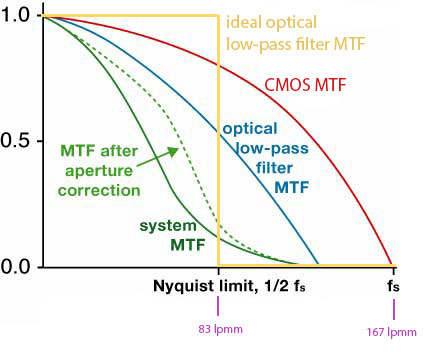
Assuming a 24MP sensor, the Nyquist frequency is equal to 83 line pairs per millimeter (lpmm), what means that details finer than 83 lpmm produce aliasing. It is here that the AA filter is necessary. Its function is to transmit without attenuation (gain of 1) all spatial frequencies lower than 83 lpmm, and attenuate completely (gain equal to 0) the frequencies above 83 lpmm. The ideal AA filter has a response as shown by the yellow curve.
Unfortunately, technological limitations make the real optical AA filter to have a very imperfect response, as shown by the blue curve. The response of a real AA filter is not flat in the range 0 to fs/2. Hgher frequencies (finer details) are more attenuated than lower frequencies. This results in a certain loss of contrast of the finer image structures. Furthermore, the AA filter response is not zero for frequencies above fs/2, which means that the risk of aliasing is reduced but not completely eliminated.
| iangreenhalgh1 wrote: |
| Considering the lack of an AA filter only gives a very modest improvement in sharpness which can be overcome by sharpening anyways and carries several downsides, then it's a very moot point as to whether a lack of AA filter is a good thing or not. |
Yes, it is true. The gradual fall off in the response in the "bandpass" region (frequencies between 0 and fs/2) can be easily corrected by sharpening in PP. The penalty is a small increase in noise, but this is imperceptible in most cases. On the contrary, artifacts due to lack of AA filter is much more difficult to be eliminated via software.
_________________
If raindrops were perfect lenses, the rainbow did not exist. |
|
| Back to top |
|
 |
tb_a


Joined: 26 Jan 2010
Posts: 3678
Location: Austria
Expire: 2019-08-28
|
 Posted: Tue Nov 24, 2015 12:37 pm Post subject: Posted: Tue Nov 24, 2015 12:37 pm Post subject: |
 |
|
tb_a wrote:
@Gerald,
thanks a lot for your explanation. At least I know now that I am not dreaming. So it's obviously the additional "glass" of the filter which is causing the troubles and not so the filtering itself, besides that the Ricoh has a slightly higher resolution.
However, from your comparison posted here earlier I would also state that the example without filtering shows a little bit more details, besides that the moire effect is more obvious.
Cheers,
_________________
Thomas Bernardy
Manual focus lenses mainly from Minolta, Pentax, Voigtlaender, Leitz, Topcon and from Russia (too many to be listed here). |
|
| Back to top |
|
 |
uhoh7

Joined: 24 Nov 2010
Posts: 1300
Location: Idaho, USA
|
 Posted: Tue Nov 24, 2015 6:52 pm Post subject: Posted: Tue Nov 24, 2015 6:52 pm Post subject: |
 |
|
uhoh7 wrote:
| iangreenhalgh1 wrote: |
Considering the lack of an AA filter only gives a very modest improvement in sharpness which can be overcome by sharpening anyways and carries several downsides, then it's a very moot point as to whether a lack of AA filter is a good thing or not. |
I thought this was not the right place to discuss these matters?
You think everything, color, and clarity can be just overcome by software. Why be picky about your lenses at all? The idea lack of AA filter can be made up by primitive software sharpening is preposterous.
Also your comments about people working to get the best out of there lenses technically, but making boring photographs anyway, is just a pointless insult directed at whom I don't even care.
This has become a very interesting thread in spite of your usual derogatory input, as the issue of sensor design and it's effects on lens performance is real and can be very large. As we view samples of various lenses it's as important to know the sensor as it was to know the type of film, in fact more so.  The idea this is somehow off topic in evaluating the samples of a given lens is crazy. Should I also ignore whether the sample is from APS-C, where corners and edges are going to be totally different? The idea this is somehow off topic in evaluating the samples of a given lens is crazy. Should I also ignore whether the sample is from APS-C, where corners and edges are going to be totally different?
If you don't care how the camera is effecting the lens, that's fine. Insisting others should not care is pretty silly since the differences can be very obvious to anyone paying attention, except the truly stubborn 
_________________
Making MFlenses safe for the letter *L*  |
|
| Back to top |
|
 |
|
|
